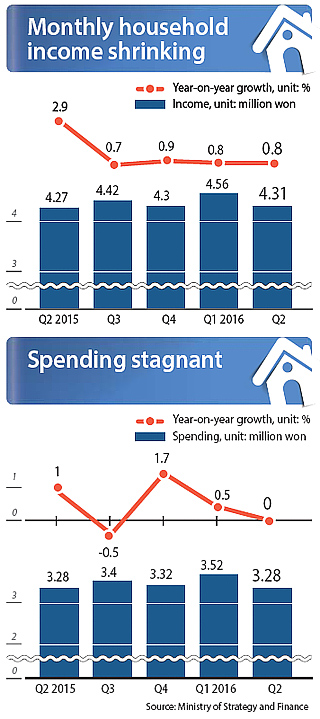Households make less, spend less

Monthly household income during the second quarter of the year averaged 4.31 million won ($3,850), according to a Statistics Korea report released Friday, a 0.8 percent increase from a year ago. But when compared to average household income during the first quarter (4.6 million won), it was a 5.46 percent drop.
“Average household income saw limited growth in the second quarter largely because income made from investments shrank sharply,” said an official at the Ministry of Strategy and Finance. “But income made from labor and businesses saw mild growth.”
Household income has been struggling since the second half of last year. After reporting a 2.9 percent year-on-year growth during the second quarter last year, household income growth has remained below 1 percent. During the second quarter this year, household income growth was even slower than the 0.9 percent inflation rate.

Even worse, the average propensity to consume in the second quarter fell to an all-time low, breaking the previous record set in the third quarter of last year.
Average propensity to consume is the fraction of disposable income that a household spends after excluding required expenditures such as taxes and insurance.
In the second quarter, the fraction amounted to 70.9 percent, while the previous record held in the third quarter was 71.5 percent, meaning people have been cutting back on spending.
Statistics Korea attributed the drop to an aging society where the number of heads of households in their 60s is increasing while the population of younger people in their 30s and 40s is shrinking.
As a result, Korean households have been cutting back on consumption of daily necessities as well as clothing and shoes. Spending on food and beverages dropped 4.2 percent year on year, clothing and shoes fell 2.5 percent and even spending on education saw a drop of 0.7 percent.
Instead, more is being spent on recreational activities and goods. Money spent on cigarettes and alcohol increased 7.1 percent, mostly because of a tax hike on tobacco enacted last January. Cigarette spending alone increased nearly 11 percent.
Spending on cultural activities and entertainment also rose during the second quarter due to extensive holidays in early May.
The Statistics Korea report showed income disparity worsened in the second quarter. Households in the lower 20 percent saw their income shrink 6 percent, whereas the top 20 percent saw a 1.7 percent increase.
BY LEE HO-JEONG [lee.hojeong@joongang.co.kr]










with the Korea JoongAng Daily
To write comments, please log in to one of the accounts.
Standards Board Policy (0/250자)